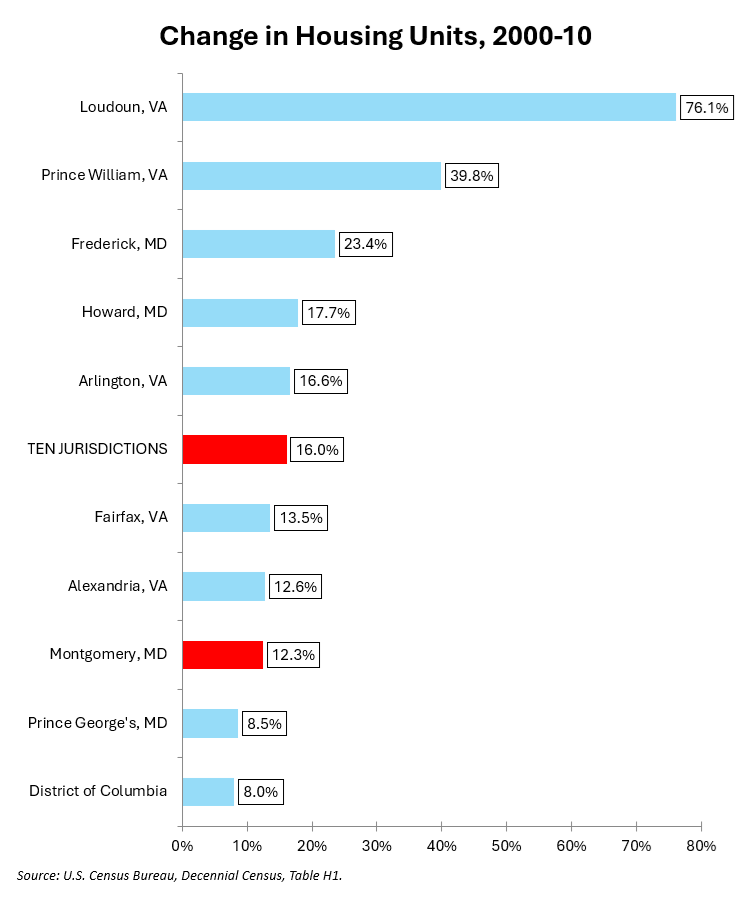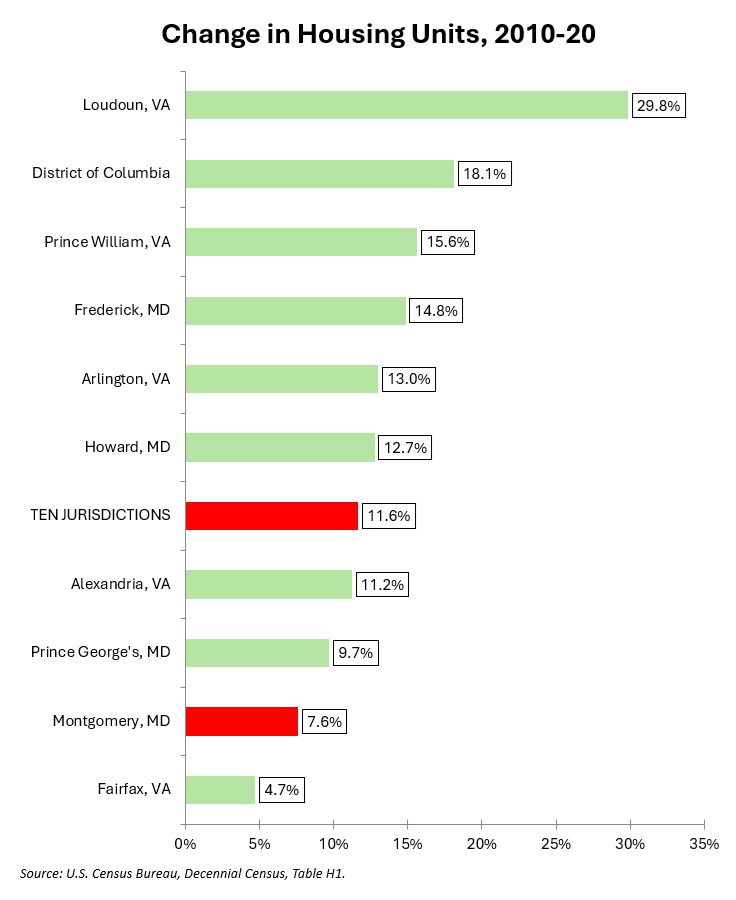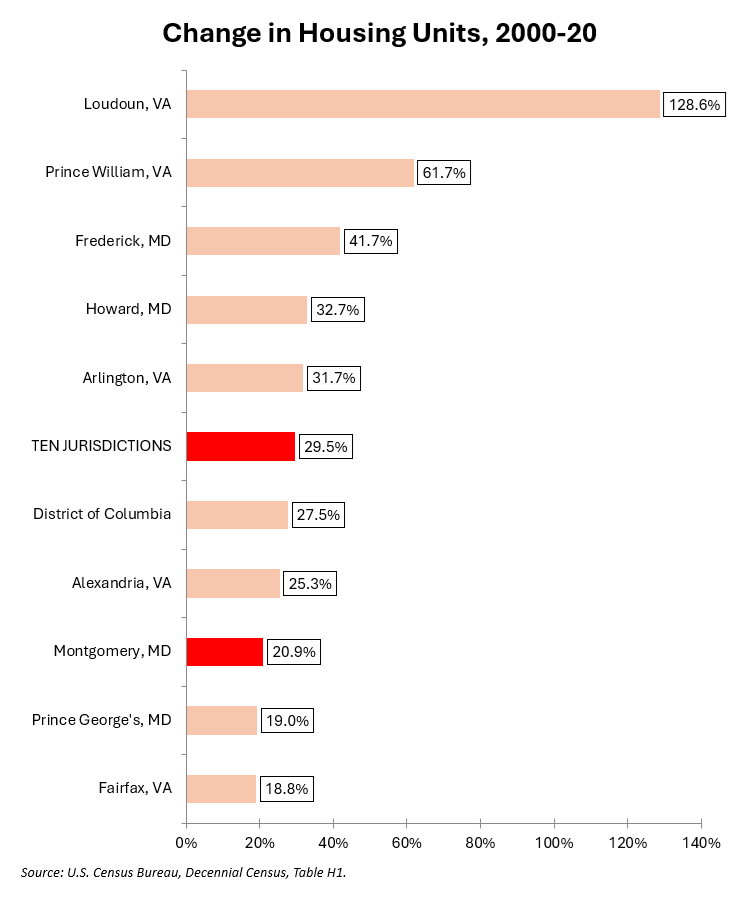By Adam Pagnucco.
Which of the following statements about the Planning Board’s hotly debated Attainable Housing Strategies initiative is true?
1. It will facilitate a surge in new housing which is badly needed to fix the county’s housing shortage.
2. It will facilitate a surge in new housing which will destroy existing neighborhoods, crowd schools and clog roads with traffic.
Answer: Neither of them. That’s because both statements contain the phrase “surge in new housing,” which most assuredly will not happen if attainable housing is passed.
Why do I say that?
First, MoCo is playing from behind when it comes to building housing. The county’s Department of Permitting Services has admitted that it has no housing unit permit data prior to 2019, so we can’t use it to measure historical homebuilding. But we can use decennial Census data. The charts below show change in housing units for the ten largest jurisdictions in the D.C. region for three periods: 2000-10, 2010-20 and 2000-20. Note how MoCo compares.



Some skeptics will say, “Of course we’re not building a lot of housing. We don’t have a lot of land for it.” If that’s the reason, then why have D.C, Arlington and Alexandria – all of which have more land constraints than we do – done better than us?
Why have we been falling short? Here’s the explanation offered by County Executive Marc Elrich to Bethesda Today in December:
“Your housing units aren’t going to be built if you don’t have the jobs,” Elrich told reporters during an Oct. 17 media meeting about the proposal.
Elrich said he bases his claim on a Metropolitan Washington Council of Government report that projected housing needs in Montgomery County. He believes that the organization miscalculated in its projection that the region needs 75,000 more housing units by 2030.
He said there aren’t enough jobs in the county to justify building more housing.
“You take your jobs number and you project how many housing units you need for it — and that’s because people don’t come here unless there are jobs,” Elrich said. “So if you don’t have enough jobs, you’re not going to build units. People are going to move here, spend a lot of money to go work someplace else and commute.”
So according to Elrich, the county’s failing jobs market justifies failure to build housing. That’s an appalling sentiment coming from the “leader” of the county whose job it is to chart a path for success, not failure.
But Elrich is not wrong when he links the two. Across the region, the jurisdictions that have seen the highest rates of job growth – Loudoun, Prince William and Frederick – have also seen the highest rates of housing growth as shown in the charts above. And many property owners in White Flint, which was set to be the crown jewel of MoCo’s transit-oriented development strategy 15 years ago, have specifically cited lack of job growth as a reason why they have not proceeded with redevelopment.
Employment stagnation and broader economic non-competitiveness are only the start. As I have previously written, MoCo has embraced a mix of tax and regulatory policies that stymie real estate development and increase housing costs. Two years ago, the county raised property taxes, recordation taxes and impact taxes and looks poised for another large property tax increase this year. It has the highest impact taxes in Maryland and has by far the highest energy taxes in the region. It has passed laws mandating all-electric buildings (currently the subject of litigation by business and labor groups) and building energy performance standards, which are threatening many commercial building, apartment and condo owners with huge cost increases. It is the only jurisdiction in the region that requires property owners to get approval from two different agencies (permitting and planning) for record plats. Our county executive promotes the “need” for higher commercial property taxes, which affect apartment buildings, at every opportunity he gets. Worst of all is the county’s new rent control law, which started killing development even before it was passed, has started to wipe out apartment building values and has resulted in our getting “redlined” by the national real estate industry.
No other place in the region does all of these things at the same time. These policies along with the county’s broad economic weakness limit any stimulative effect of land use changes or housing reforms.
During my time in this county, the most sweeping land use policy change was not attainable housing or Thrive 2050 – it was the 2014 zoning rewrite, which introduced mixed commercial-residential (CR) zones into the county’s ordinance. It was designed to spark a boom in modern mixed-use projects. What has it actually brought? There have been quite a few projects in Downtown Bethesda (which the neighbors have noticed) and Pike and Rose went up, but the former White Flint mall is a gaping crater, the Glenmont shopping center rots in decrepitude, Gaithersburg West (which is outside city limits) never happened, Downtown Silver Spring has lost its momentum and much of the rest of the county has seen incremental improvement if that. The accessory dwelling unit reform of 2019, the biggest land use fight of that time, has produced dozens of new units per year. Not thousands, not hundreds – dozens. As for growth overall, impact tax receipts charged on new projects have collapsed, which even Elrich has conceded is due to “sluggish development activity.”
Why has this happened? Put yourself in the shoes of real estate investors who are considering where to put their money. Now look at the tax and regulatory policy mix above. When county leaders follow up all of that with an offer to loosen land use rules, here is the message they send to investors: “We’re open to letting you do whatever you want. Except make money.”
Who on Earth wants to invest in a place like that? Especially when MoCo is surrounded by more rational jurisdictions on every side? It’s no wonder that we have been redlined by national real estate investors!
And so with draconian suppression of real estate returns, our housing construction capacity is mostly reduced to nonprofit projects requiring heavy government subsidies. According to its affordable housing pipeline reports, the county spends tens of millions of dollars each year subsidizing housing projects and preserves or builds hundreds of units each year. That’s not a bad thing, but consider that according to the U.S. Census Bureau, MoCo had more than 400,000 housing units in 2023. And still home prices are soaring because we have a housing shortage.
It’s not enough. It will never be enough. We could abolish zoning altogether like Houston, but as long as we keep crushing the economics of real estate development, we won’t get a lot of it.
But hey, we’ll still have our land use debates. Because after all, we’re Montgomery County.
